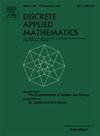Some results on the saturation number of graphs
IF 1
3区 数学
Q3 MATHEMATICS, APPLIED
引用次数: 0
Abstract
For a given graph , we say a (connected) graph is (connected) -saturated if is -free, and for any , creates an -copy. The (connected) saturation number is the minimum number of edges of a (connected) -saturated graph with vertices. We denote the saturation number and the connected saturation number by and , respectively. Evidently, . A generalized friendship graph is regarded as the join of a clique and the union of some disjoint cliques. In this paper, we show the relationship of the saturation numbers between the unions of disjoint cliques and generalized friendship graphs, and as its application, obtain the saturation numbers of some generalized friendship graphs. And then we propose respectively two sufficient conditions for and . In addition, we show for sufficiently large and . Furthermore, we obtain an upper bound of the saturation number of for .
关于图的饱和数的一些结果
对于给定的图F,我们说(连通)图G是(连通)F饱和的,如果G是F自由的,并且对于任何e∈e (G¯),G+e创建一个F副本。(连通的)饱和数是具有n个顶点的(连通的)f饱和图的最小边数。饱和数和连通饱和数分别用sat(n,F)和satc(n,F)表示。显然,坐(n、F)≤一部satc (n、F)里。广义友谊图被看作是一个小团体的联结点和一些不联结点的小团体的联结点。本文给出了不相交团的并与广义友图的饱和数的关系,并作为其应用,得到了一些广义友图的饱和数。然后分别提出了sat(n,F)=satc(n,F)和sat(n,F)<satc(n,F)的两个充分条件。此外,我们证明了当n足够大且k≥4时,satc(n,Pk∪K3)=n+2。进一步,我们得到了k≥6时Pk∪K3饱和数的上界。
本文章由计算机程序翻译,如有差异,请以英文原文为准。
求助全文
约1分钟内获得全文
求助全文
来源期刊

Discrete Applied Mathematics
数学-应用数学
CiteScore
2.30
自引率
9.10%
发文量
422
审稿时长
4.5 months
期刊介绍:
The aim of Discrete Applied Mathematics is to bring together research papers in different areas of algorithmic and applicable discrete mathematics as well as applications of combinatorial mathematics to informatics and various areas of science and technology. Contributions presented to the journal can be research papers, short notes, surveys, and possibly research problems. The "Communications" section will be devoted to the fastest possible publication of recent research results that are checked and recommended for publication by a member of the Editorial Board. The journal will also publish a limited number of book announcements as well as proceedings of conferences. These proceedings will be fully refereed and adhere to the normal standards of the journal.
Potential authors are advised to view the journal and the open calls-for-papers of special issues before submitting their manuscripts. Only high-quality, original work that is within the scope of the journal or the targeted special issue will be considered.
 求助内容:
求助内容: 应助结果提醒方式:
应助结果提醒方式:


